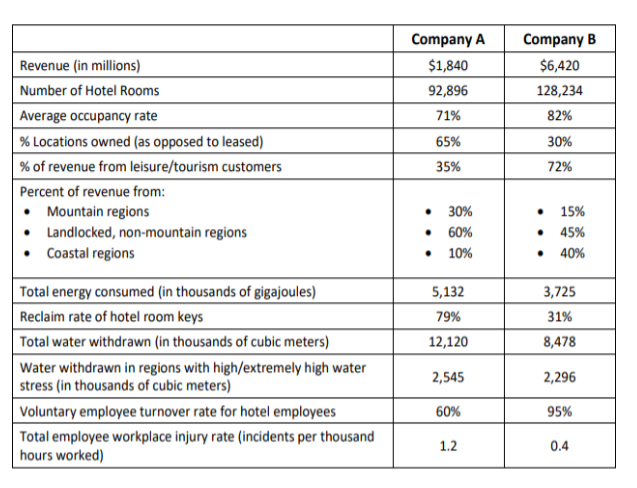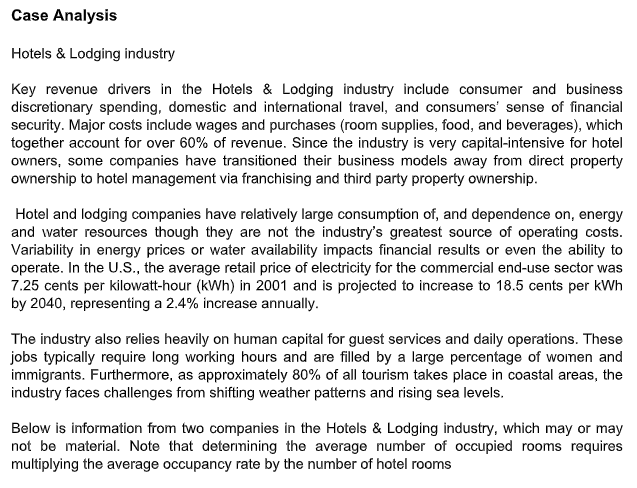Why the answer is letter D. Company A’s lower voluntary employee turnover rate will likely increase valuation? How will performance on SASB metrics impact Company A’s valuation as compared to Company B? A. Company B’s higher percentage of revenue from leisure customers will likely decrease valuation. B. Company B’s lower reclamation rate of hotel room keys will likely increase valuation. C. Company A’s lower percentage of revenue from coastal regions will likely decrease valuation. D. Company A’s lower voluntary employee turnover rate will likely increase valuation
Why the answer is letter D. Company A’s lower voluntary employee turnover rate will likely increase valuation? How will performance on SASB metrics impact Company A’s valuation as compared to Company B? A. Company B’s higher percentage of revenue from leisure customers will likely decrease valuation. B. Company B’s lower reclamation rate of hotel room keys will likely increase valuation. C. Company A’s lower percentage of revenue from coastal regions will likely decrease valuation. D. Company A’s lower voluntary employee turnover rate will likely increase valuation
Financial Reporting, Financial Statement Analysis and Valuation
8th Edition
ISBN:9781285190907
Author:James M. Wahlen, Stephen P. Baginski, Mark Bradshaw
Publisher:James M. Wahlen, Stephen P. Baginski, Mark Bradshaw
Chapter4: Profitability Analysis
Section: Chapter Questions
Problem 27PC: Starwood Hotels (Starwood) owns and operates many hotel properties under well-known brand names,...
Related questions
Question
Why the answer is letter D. Company A’s lower voluntary employee turnover rate will likely increase valuation?
How will performance on SASB metrics impact Company A’s valuation as compared to Company B?
A. Company B’s higher percentage of revenue from leisure customers will likely decrease valuation.
B. Company B’s lower reclamation rate of hotel room keys will likely increase valuation.
C. Company A’s lower percentage of revenue from coastal regions will likely decrease valuation.
D. Company A’s lower voluntary employee turnover rate will likely increase valuation

Transcribed Image Text:Company A
Company B
Revenue (in millions)
$1,840
$6,420
Number of Hotel Rooms
92,896
128,234
Average occupancy rate
71%
82%
|% Locations owned (as opposed to leased)
65%
30%
% of revenue from leisure/tourism customers
35%
72%
Percent of revenue from:
Mountain regions
30%
15%
• Landlocked, non-mountain regions
• Coastal regions
• 60%
• 10%
• 45%
• 40%
| Total energy consumed (in thousands of gigajoules)
5,132
3,725
Reclaim rate of hotel room keys
79%
31%
Total water withdrawn (in thousands of cubic meters)
12,120
8,478
Water withdrawn in regions with high/extremely high water
stress (in thousands of cubic meters)
2,545
2,296
Voluntary employee turnover rate for hotel employees
60%
95%
Total employee workplace injury rate (incidents per thousand
hours worked)
1.2
0.4

Transcribed Image Text:Case Analysis
Hotels & Lodging industry
Key revenue drivers in the Hotels & Lodging industry include consumer and business
discretionary spending, domestic and international travel, and consumers' sense of financial
security. Major costs include wages and purchases (room supplies, food, and beverages), which
together account for over 60% of revenue. Since the industry is very capital-intensive for hotel
owners, some companies have transitioned their business models away from direct property
ownership to hotel management via franchising and third party property ownership.
Hotel and lodging companies have relatively large consumption of, and dependence on, energy
and water resources though they are not the industry's greatest source of operating costs.
Variability in energy prices or water availability impacts financial results or even the ability to
operate. In the U.S., the average retail price of electricity for the commercial end-use sector was
7.25 cents per kilowatt-hour (kWh) in 2001 and is projected to increase to 18.5 cents per kWh
by 2040, representing a 2.4% increase annually.
The industry also relies heavily on human capital for guest services and daily operations. These
jobs typically require long working hours and are filled by a large percentage of women and
immigrants. Furthermore, as approximately 80% of all tourism takes place in coastal areas, the
industry faces challenges from shifting weather patterns and rising sea levels.
Below is information from two companies in the Hotels & Lodging industry, which may or may
not be material. Note that determining the average number of occupied rooms requires
multiplying the average occupancy rate by the number of hotel rooms
Expert Solution
This question has been solved!
Explore an expertly crafted, step-by-step solution for a thorough understanding of key concepts.
This is a popular solution!
Trending now
This is a popular solution!
Step by step
Solved in 2 steps

Knowledge Booster
Learn more about
Need a deep-dive on the concept behind this application? Look no further. Learn more about this topic, accounting and related others by exploring similar questions and additional content below.Recommended textbooks for you

Financial Reporting, Financial Statement Analysis…
Finance
ISBN:
9781285190907
Author:
James M. Wahlen, Stephen P. Baginski, Mark Bradshaw
Publisher:
Cengage Learning

Managerial Accounting
Accounting
ISBN:
9781337912020
Author:
Carl Warren, Ph.d. Cma William B. Tayler
Publisher:
South-Western College Pub

Financial And Managerial Accounting
Accounting
ISBN:
9781337902663
Author:
WARREN, Carl S.
Publisher:
Cengage Learning,

Financial Reporting, Financial Statement Analysis…
Finance
ISBN:
9781285190907
Author:
James M. Wahlen, Stephen P. Baginski, Mark Bradshaw
Publisher:
Cengage Learning

Managerial Accounting
Accounting
ISBN:
9781337912020
Author:
Carl Warren, Ph.d. Cma William B. Tayler
Publisher:
South-Western College Pub

Financial And Managerial Accounting
Accounting
ISBN:
9781337902663
Author:
WARREN, Carl S.
Publisher:
Cengage Learning,

Principles of Accounting Volume 2
Accounting
ISBN:
9781947172609
Author:
OpenStax
Publisher:
OpenStax College

Managerial Accounting: The Cornerstone of Busines…
Accounting
ISBN:
9781337115773
Author:
Maryanne M. Mowen, Don R. Hansen, Dan L. Heitger
Publisher:
Cengage Learning